1993 CADILLAC FLEETWOOD check engine light
[x] Cancel search: check engine lightPage 207 of 386
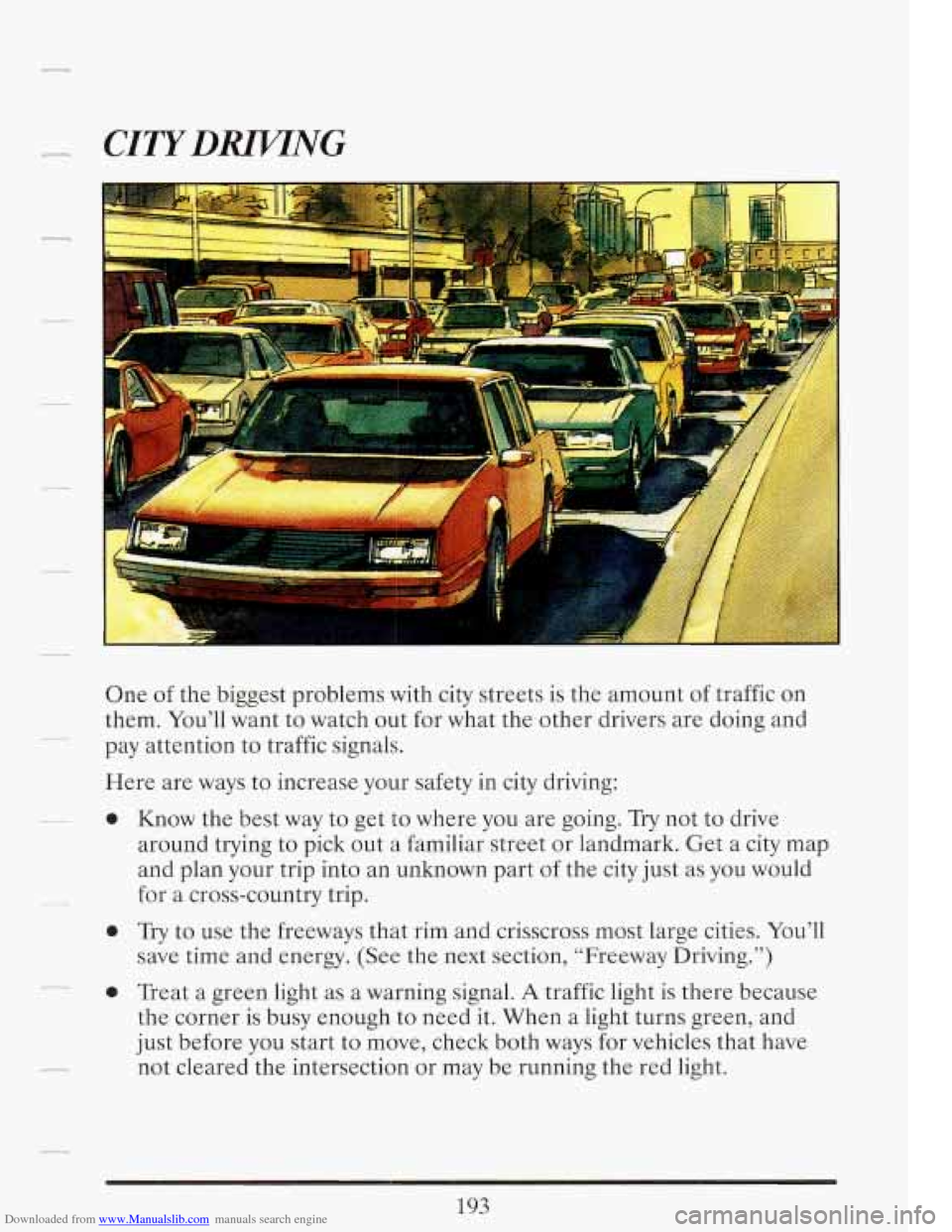
Downloaded from www.Manualslib.com manuals search engine One of the biggest problems with city streets is the amount of traffic on
them. You’ll want to watch out for what the other drivers are doing and
pay attention to traffic signals.
Here are ways to increase your safety in city driving:
---
0
.-._- 0
Know the best way to get to where you are going. Try not to drive
around trying to pick
out a familiar street or landmark. Get a city map
and plan your trip into an unknown part of the city just as
you would
for a cross-country trip.
Try to use the freeways that rim and crisscross most large cities. You’ll
save time and energy. (See the next section, “Freeway Driving.”)
Treat a green light as a warning signal.
A traffic light is there because
the corner is busy enough to need it. When a light turns green, and
just before you start to move, check both ways for vehicles that have
not cleared the intersection or may be running the red light.
193
Page 208 of 386

Downloaded from www.Manualslib.com manuals search engine Obey all posted speed limits. But remember that they are for ideal
road, weather and visibility conditions.
You may need to drive below
the posted limit in bad weather or when visibility is especially poor.
Pull to the right (with care) and stop clear of intersections when you
see or hear emergency vehicles.
FREEWAYDMNG
r
-,
Mile for mile, freeways (also called thruways, parkways, expressways,
turnpikes, or superhighways) are the safest of all roads. But they have
their own special rules. 1
The most important advice on freeway driving is: Keep up with traffic and -
keep to the right. Drive at the same speed most of the other drivers are d
driving. Too-fast or too-slow driving breaks a smooth traffic flow. Treat
the left lane on a freeway as a passing lane.
Entering the Freeway
.-
It
At the entrance there is usually a ramp that leads to the freeway. If you
have a clear view of the freeway as you drive along the entrance ramp,
you should begin
to check traffic. Try to determine where you expect to
blend with the flow. If traffic is light, you may have no problem. But
if it is -
heavy, find a gap as you move along the entering lane and time your
approach. Try to merge into the gap at close to the prevailing speed. u
194
Page 209 of 386
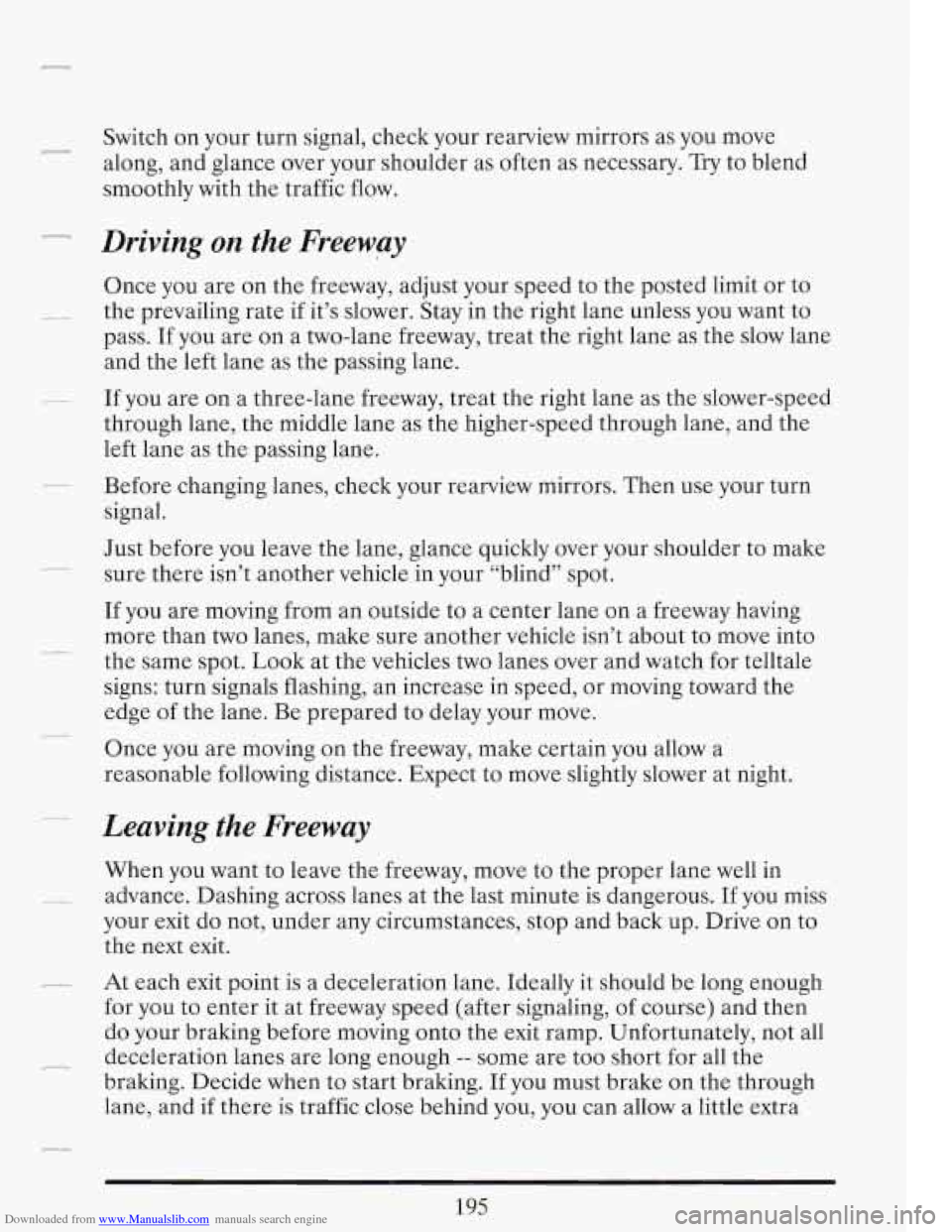
Downloaded from www.Manualslib.com manuals search engine r
Switch on your turn signal, check your rearview mirrors as you move
along, and glance over your shoulder as often as necessary.
Try to blend
smoothly with the traffic flow. c-
_I Driving on the Freeway
Once you are on the freeway, adjust your speed to the posted limit or to
-- the prevailing rate if it’s slower. Stay in the right lane unless you want to
pass.
If you are on a two-lane freeway, treat the right lane as the slow lane
and the left lane as the passing lane.
through lane, the middle lane as the higher-speed through lane, and the
left lane as the passing lane.
- If you are on a three-lane freeway, treat the right lane as the slower-speed
L_ Before changing lanes, check your rearview mirrors. Then use your turn
signal.
Just before you leave the lane, glance quickly over your shoulder to make
sure there isn’t another vehicle in your “blind” spot.
If you are moving from an outside to
a center lane on a freeway having
more than two lanes, make sure another vehicle isn’t about to move into
the same spot. Look at the vehicles
two lanes over and watch for telltale
signs: turn signals flashing, an increase in speed, or moving toward the
edge
of the lane. Be prepared to delay your move.
-
._.
_I
Once you are moving on the freeway, make certain you allow a
reasonable following distance. Expect to move slightly slower at night.
c_
Leaving the Freeway
When you want to leave the freeway, move to the proper lane well in
__ advance. Dashing across lanes at the last minute is dangerous. If you miss
your exit do not, under any circumstances, stop and back up. Drive on to
the next exit.
- At each exit point is a deceleration lane. Ideally it should be long enough
for you to enter it at freeway speed (after signaling, of course) and then
do your braking before moving onto the exit ramp. Unfortunately, not all
braking. Decide when to start braking.
If you must brake on the through
lane, and
if there is traffic close behind you, you can allow a little extra
- deceleration lanes are long enough -- some are too short for all the
195
Page 210 of 386
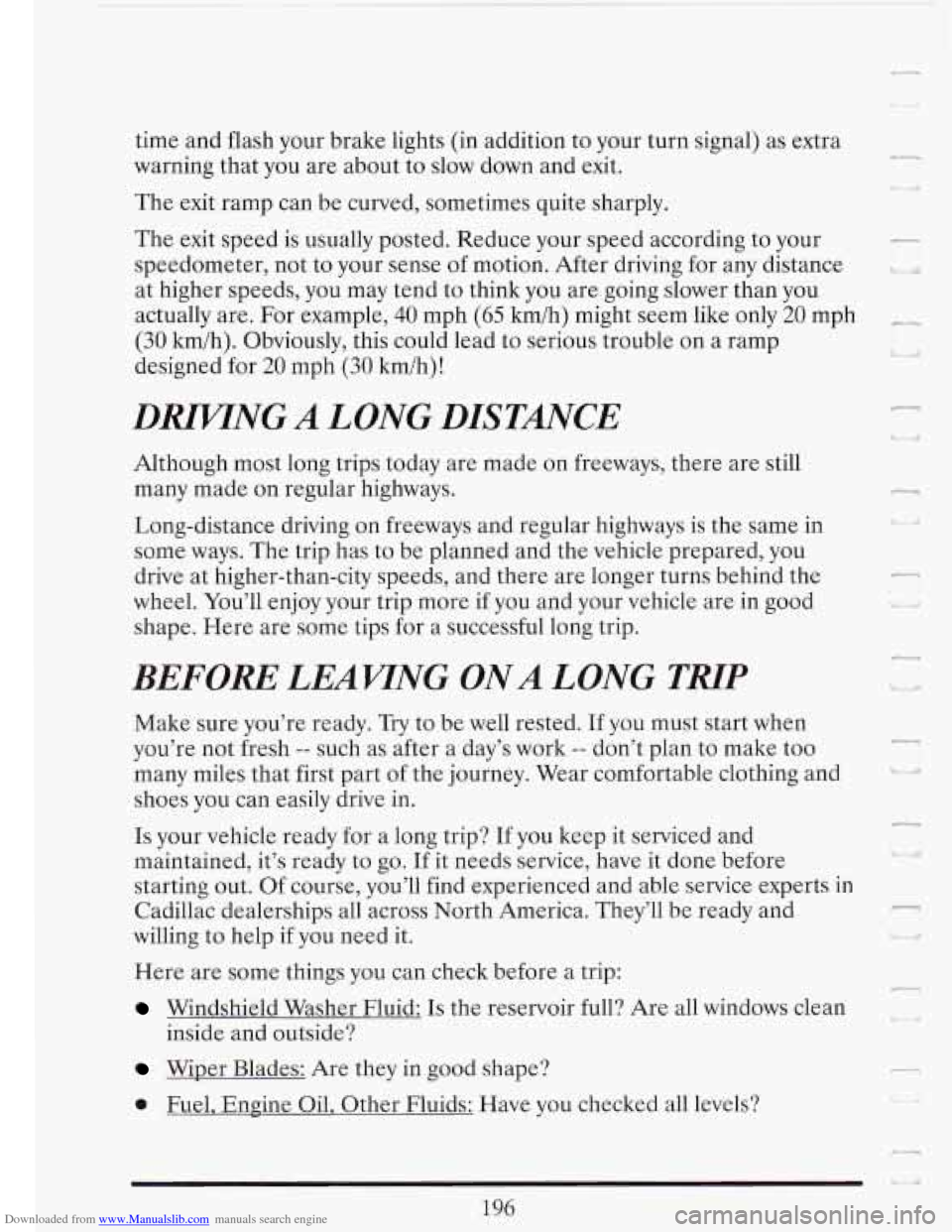
Downloaded from www.Manualslib.com manuals search engine time and flash your brake lights (in addition to your turn signal) as extra
warning that you are about to slow down and exit.
The exit ramp can be curved, sometimes quite sharply.
-.
U t I! The exit speed is usually posted. Reduce your speed according to your
speedometer, not to your sense
of motion. After driving for any distance
at higher speeds, you may tend to think you are going slower than you
actually are. For example,
40 mph (65 h/h) might seem like only 20 mph c_?
(30 km/h). Obviously, this could lead to serious trouble on a ramp
designed for
20 mph (30 kmih)!
I
L/
DRIVTNG A LONG DISTANCE
Although most long trips today are made on freeways, there are still
many made on regular highways.
Long-distance driving on freeways and regular highways is the same in
some ways. The trip has
to be planned and the vehicle prepared, you
drive at higher-than-city speeds, and there are longer turns behind the
wheel. You’ll enjoy your trip more if you and your vehicle are in good
shape. Here are some tips for a successful long trip.
BEFORE LEAWNG ONA LONG TRlP
Make sure you’re ready. Try to be well rested. If you must start when
you’re not fresh
-- such as after a day’s work -- don’t plan to make too
many miles that first part of the journey. Wear comfortable clothing and
shoes you can easily drive in.
.3
I
F i ! u
Is your vehicle ready for a long trip? If you keep it serviced and
maintained, it’s ready to
go. If it needs service, have it done before
starting out. Of course, you’ll find experienced and able service experts in
Cadillac dealerships all across North America. They’ll be ready and
7
willing to help if you need it. -1
Here are some things you can check before a trip:
Windshield Washer Fluid: Is the reservoir full? Are all windows clean
inside and outside?
Wiper Blades: Are they in good shape?
0 Fuel, Engine Oil, Other Fluids: Have you checked all levels?
Page 212 of 386
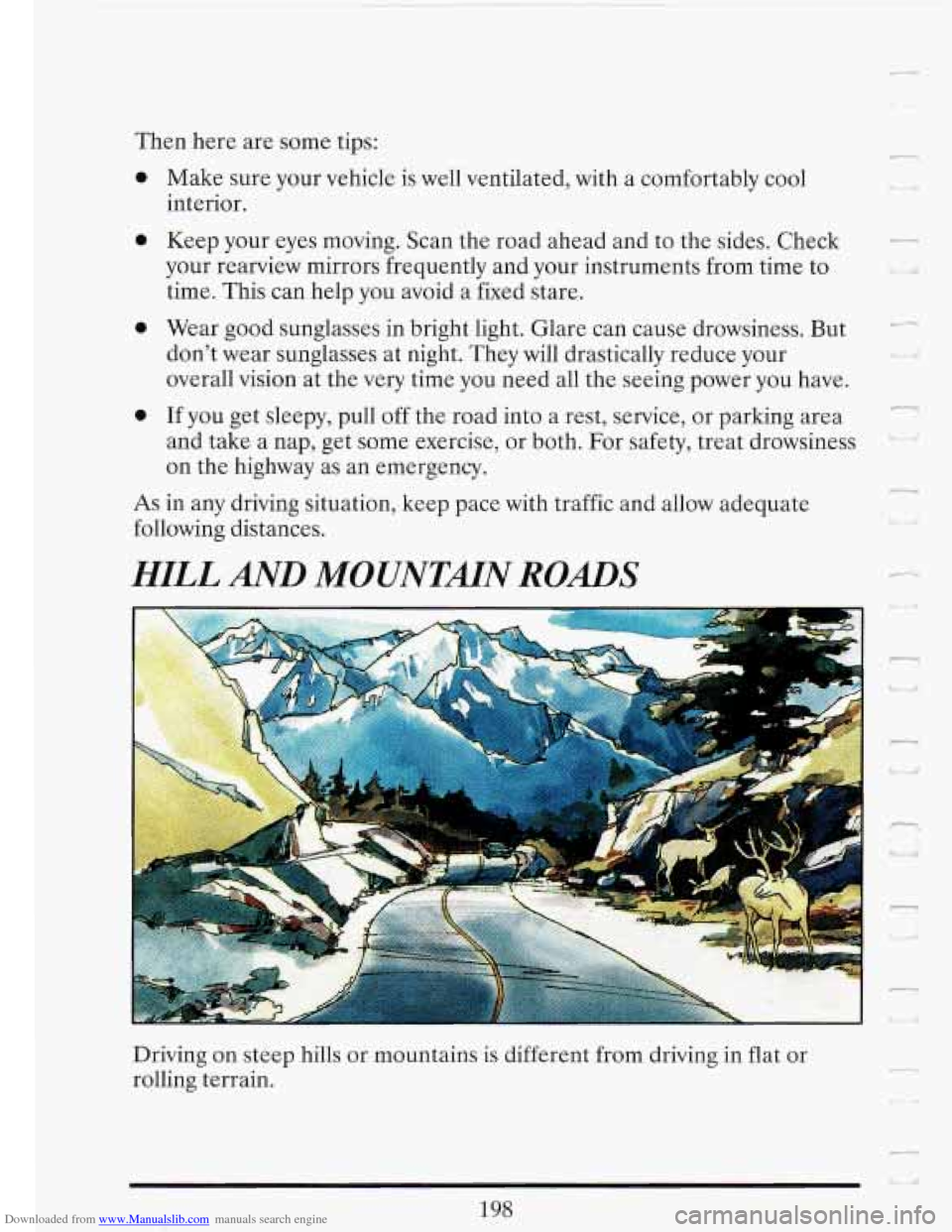
Downloaded from www.Manualslib.com manuals search engine Then here are some tips:
0
0
0
0
Make sure your vehicle is well ventilated, with a comfortably cool
interior.
Keep your eyes moving. Scan the road ahead and to the sides. Check
your rearview mirrors frequently and your instruments from time to
time. This can help you avoid a fixed stare.
1
U
I'
Wear good sunglasses in bright light. Glare can cause drowsiness. But --
don't wear sunglasses at night. They will drastically reduce your -
overall vision at the very time you need all the seeing power you have.
If you get sleepy, pull off the road into a rest, service, or parking area
and take a nap, get some exercise, or both. For safety, treat drowsiness
on the highway as an emergency.
Pl
As in any driving situation, keep pace with traffic and allow adequate
following distances.
HILL AND MOUNTMN ROADS
r
Driving on steep hills or mountains is different from driving in flat or
rolling terrain.
n
i
198
Page 221 of 386
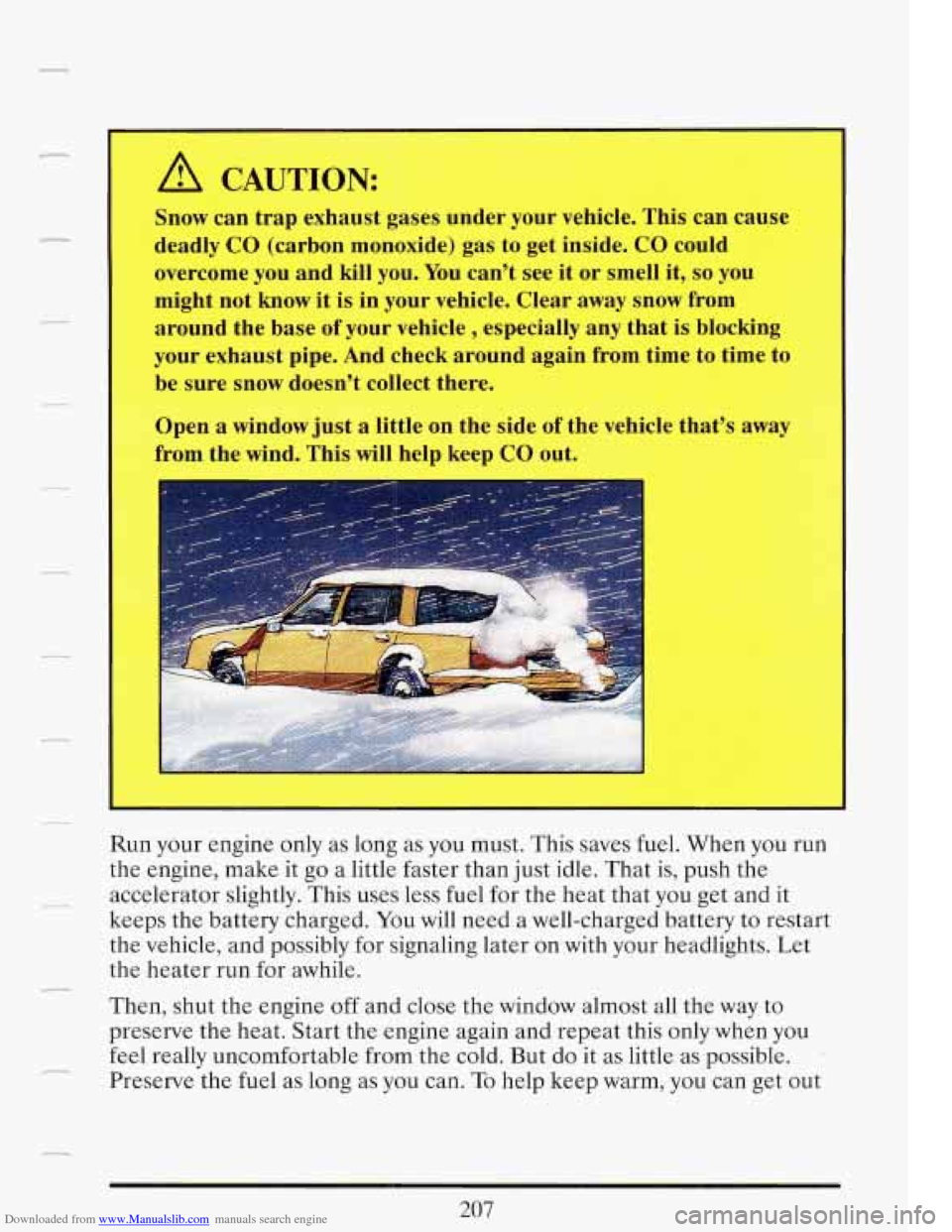
Downloaded from www.Manualslib.com manuals search engine A CAUTION:
Snow can trap exhaust gases under your vehicle. This can cause
deadly CO (carbon monoxide) gas to get inside. CO could
overcome you and kill you. You can’t see it or smell it,
so you
might not know it is in your vehicle. Clear away snow from
around the base
of your vehicle , especially any that is blocking
your exhaust pipe. And check around again from time to time to
be sure snow doesn’t collect there.
Open a window just a little on the side
of the vehicle that’s away
from the wind. This will help keep CO out.
Run your engine only as long as you must. This saves fuel. When you run
the engine, make it go a little faster than just idle. That is, push the
accelerator slightly. This uses less fuel for the heat that you get and it
keeps the battery charged. You
will need a well-charged battery to restart
the vehicle, and possibly for signaling later
on with your headlights. Let
the heater run for awhile.
207
Then, shut the engine off and close the window almost all the way to
preserve the heat. Start the engine again and repeat this only when you
feel really uncomfortable from the cold. But
do it as little as possible.
Preserve the fuel as long as you can. To help keep warm, you can get out
Page 226 of 386
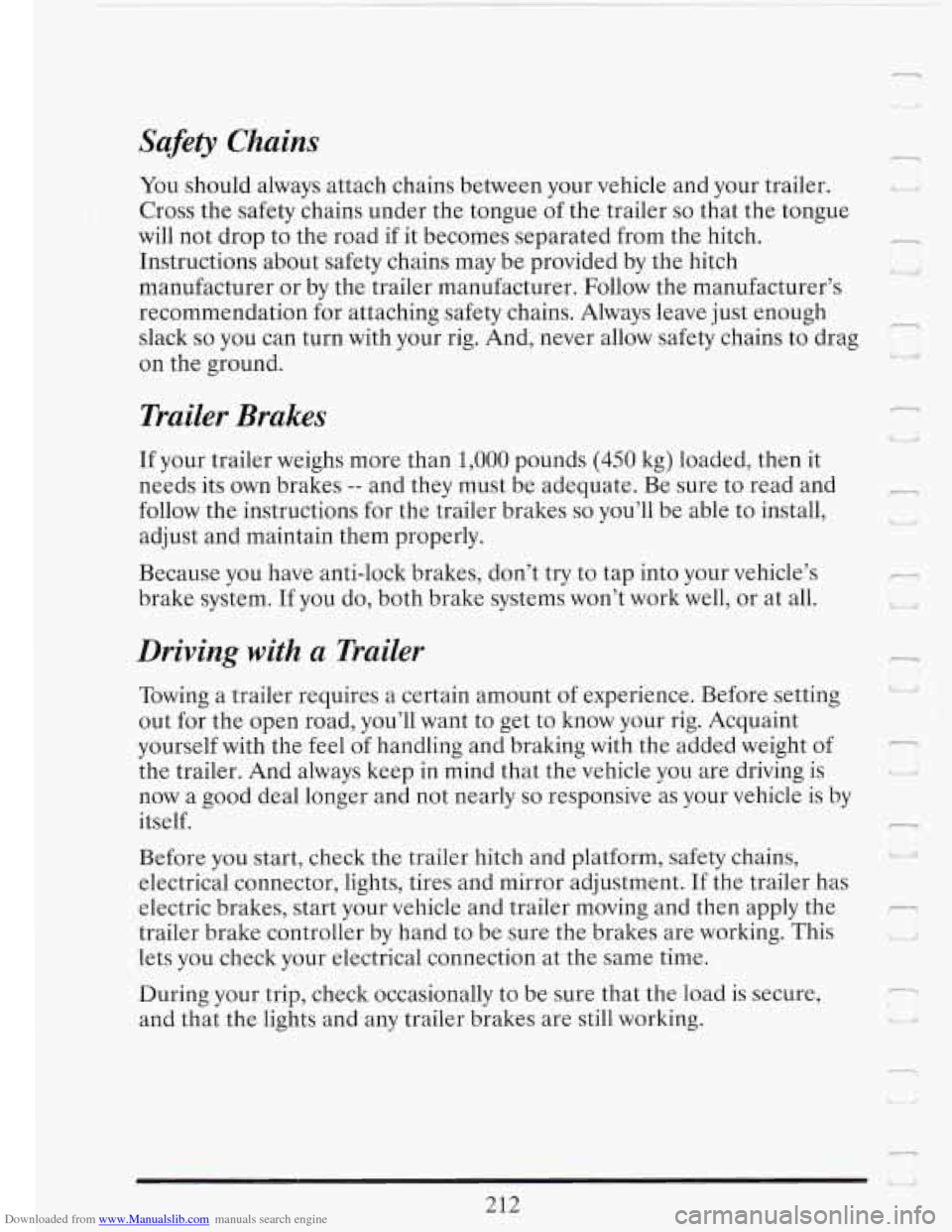
Downloaded from www.Manualslib.com manuals search engine Safety Chains
You should always attach chains between your vehicle and your trailer.
Cross the safety chains under the tongue
of the trailer so that the tongue
will not drop to the road if it becomes separated from the hitch.
Instructions about safety chains may be provided by the hitch
manufacturer or by the trailer manufacturer. Follow the manufacturer’s
recommendation for attaching safety chains. Always leave just enough
slack
so you can turn with your rig. And, never allow safety chains to drag
on the ground.
-
,-
Trailer Brakes
If your trailer weighs more than 1,000 pounds (450 kg) loaded, then it
needs its
own brakes -- and they must be adequate. Be sure to read and
follow the instructions for the trailer brakes
so you’ll be able to install,
adjust and maintain them properly.
Because
you have anti-lock brakes, don’t try to tap into your vehicle’s
brake system. If you do, both brake systems won’t work well, or at all.
Driving with a Trailer
Towing a trailer requires a certain amount of experience. Before setting
out for the open road, you’ll want to get to know your rig. Acquaint
yourself with the feel of handling and braking with the added weight of
the trailer. And always keep
in mind that the vehicle you are driving is
now a good deal longer and not nearly
so responsive as your vehicle is by
itself.
-
Before you start, check the trailer hitch and platform, safety chains, ..
electrical connector, lights, tires and mirror adjustment. If the trailer has
electric brakes, start your vehicle and trailer moving and then apply the
trailer brake controller by hand to be sure the brakes are working. This
lets you check your electrical connection at the same time.
During your trip, check occasionally to be sure that the load
is secure,
and that the lights and any trailer brakes are still working.
212
Page 227 of 386
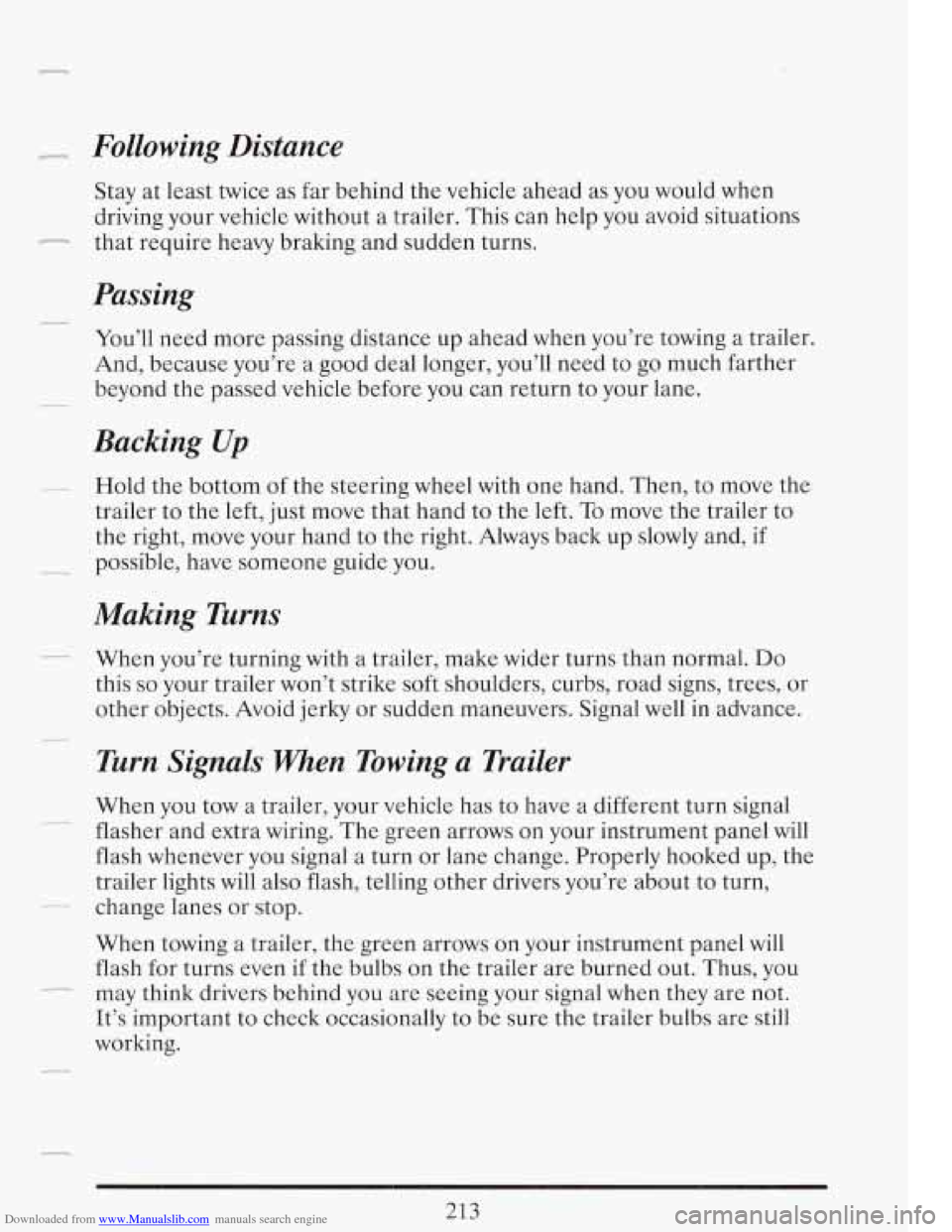
Downloaded from www.Manualslib.com manuals search engine - Following Distance
Stay at least twice as far behind the vehicle ahead as you would when
driving your vehicle without a trailer. This can help you avoid situations
- that require heavy braking and sudden turns.
Passing
I_
You’ll need more passing distance up ahead when you’re towing a trailer.
And, because you’re a good deal longer, you’ll need to go much farther
beyond the passed vehicle before you can return to your lane.
-
Backing Up
_- Hold the bottom of the steering wheel with one hand. Then, to move the
trailer to the left, just move that hand to the left.
To move the trailer to
the right, move your hand
to the right. Always back up slowly and, if
- possible, have someone guide you.
Making Turns
When you’re turning with a trailer, make wider turns than normal. Do
this so your trailer won’t strike soft shoulders, curbs, road signs, trees, or
other objects. Avoid jerky or sudden maneuvers. Signal well in advance.
1urn Signals When Towing a Trailer
When you tow a trailer, your vehicle has to have a different turn signal
flasher and extra wiring. The green arrows on your instrument panel will
flash whenever you signal a turn or lane change. Properly hooked up, the
trailer lights will also flash, telling other drivers you’re about to turn, -
- change lanes or stop.
213
When towing a trailer, the green arrows on your instrument panel will
flash for turns even
if the bulbs on the trailer are burned out. Thus, you
may think drivers behind you are seeing your signal when they are not.
It’s important to check occasionally to be sure the trailer bulbs are still
working. p__-_.